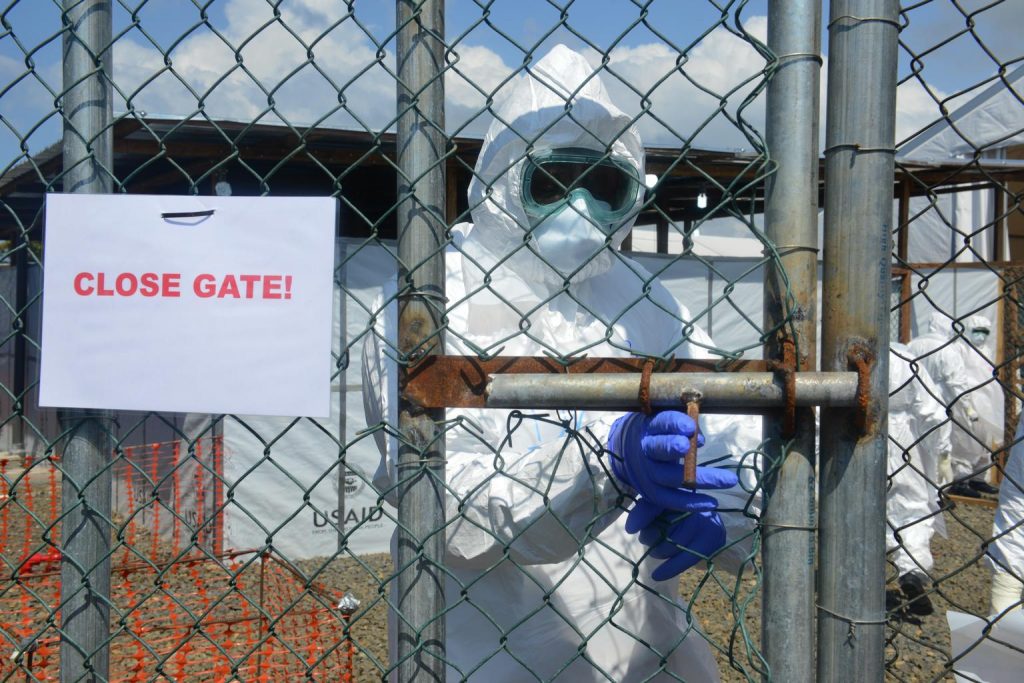Nicholas B. King looks back at the dialectics of confidence and paranoia in the Ebola outbreaks of 1995 and 2014.
Evidence Reviews
Ebola, 1995/2014
Regions
West and Central Africa
UNICEF/UNI174680/Nesbitt
On 13 November 2014, a health worker wearing personal protective equipment (PPE) closes a gate leading out of the green (safe) zone, at a newly built Ebola treatment unit (ETU) in Monrovia, the capital. He is among a group of health workers preparing to enter the Units red (high-risk) zone to treat patients. All personnel working directly with quarantined Ebola patients must don the protective gear (a combination of coveralls, heavy duty gloves and boots, goggles and aprons) before entering the high-risk zone, to prevent exposure to the virus. The treatment unit, located in Monrovias Congotown neighbourhood, near the Ministry of Defence compound, is comprised of health workers from Liberia, Cuba and African Union countries. UNICEF is supplying water to meet the drinking, washing, bathing and disinfecting needs for patients at the health facility, which has two chlorine disinfecting stations. At least 150 litres of water is required to fully care for each Ebola patient 10 times the amount that a Liberian normally uses. The ETU is one of two built in October 2014 with support from UNICEF, USAID, the World Food Programme (WFP), the World Health Organization (WHO) and the Liberian Government, to help treat the overflow of Ebola patients at other health facilities. The units each have a 100-bed capacity.
In November 2014, Liberia remains one of three countries in West Africa experiencing widespread and intense transmission of Ebola virus disease (EVD). UNICEF continues to support social mobilization efforts to raise awareness of the disease, its symptoms and how to prevent its spread all of which are critical to curtailing the unprecedented outbreak. UNICEF remains at the forefront of efforts to respond to and help curtail the outbreak. Since the beginning of the outbreak, UNICEF has brought in 967 metric tons of emergency aid, including essential protective gear, tents, diarrhoeal kits, emergency health kits, and sanitation supplies such as chlorine.
Related content
Infographics
Key Considerations: Child Engagement in the Context of Disease Outbreaks in Eastern and Southern Africa
This infographic summarises the insights from a recent key considerations brief on child engagement in the context of disease outbreaks in Eastern and Southern Africa. This brief explores why, when and how to engage children in the prevention, response and…
Central and East Africa Hub
SSHAP
2024
Infographics
Key Considerations for Responding to Floods in South Sudan Through the Humanitarian-Peace-Development Nexus
This infographic summarises the insights from a recent key considerations brief on responding to floods in South Sudan through the lens of Humanitarian-Peace-Development (HDP) Nexus. The brief describes the multidimensional impacts of flooding on peace, health, livelihoods and governance and…
Central and East Africa Hub
SSHAP
2024
Briefing
Key Considerations: Child Engagement in the Context of Disease Outbreaks in Eastern and Southern Africa
Effective child engagement strategies are essential to optimise the response to disease outbreaks and minimise their impact while ensuring children’s protection, well-being and resilience. When children understand disease outbreaks, they are better able to cope, contribute and recover. This promotes…
Central and East Africa Hub
SSHAP
2024
Briefing
Key Considerations for Responding to Floods in South Sudan Through the Humanitarian-Peace-Development Nexus
In common with many other African countries, the Republic of South Sudan is increasingly experiencing devastating floods linked to climate change.1,2 The Indian Ocean Dipole (IOD) and El Niño regulate the climate of Equatorial Eastern Africa. In 2019, a dipole…
Central and East Africa Hub
SSHAP
2024


